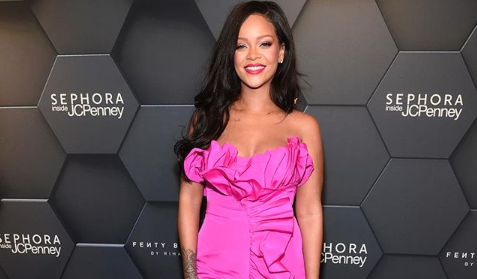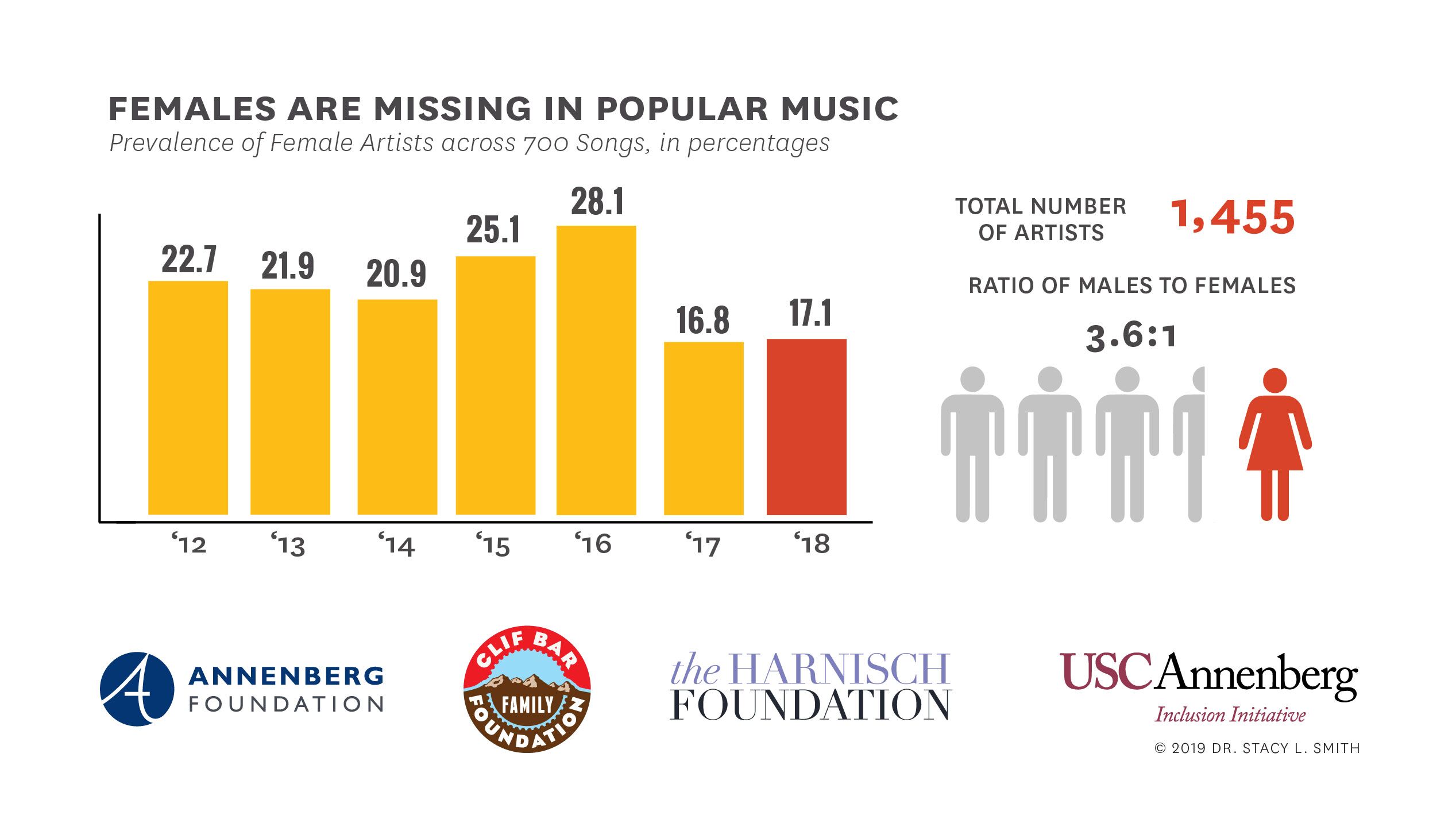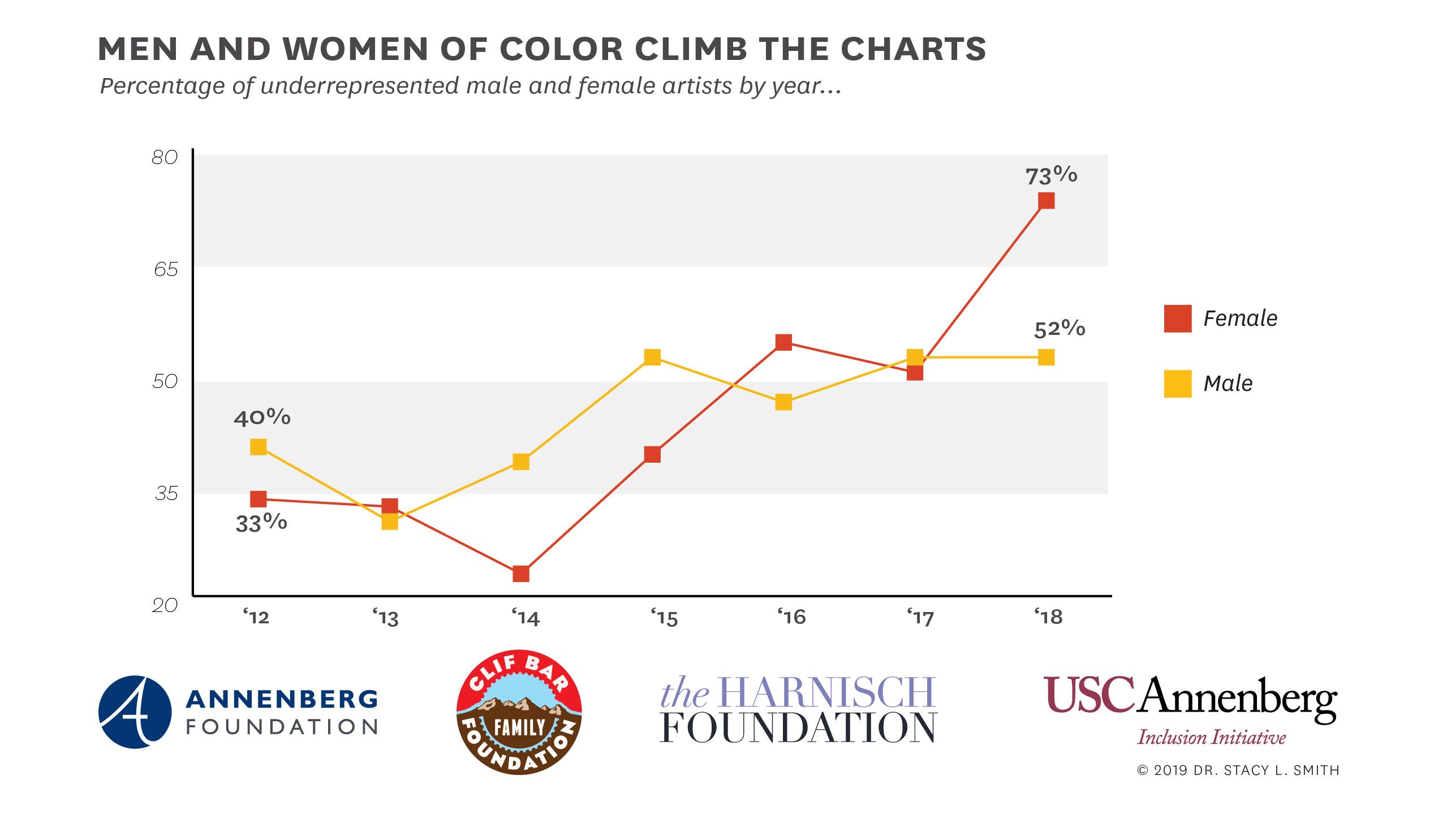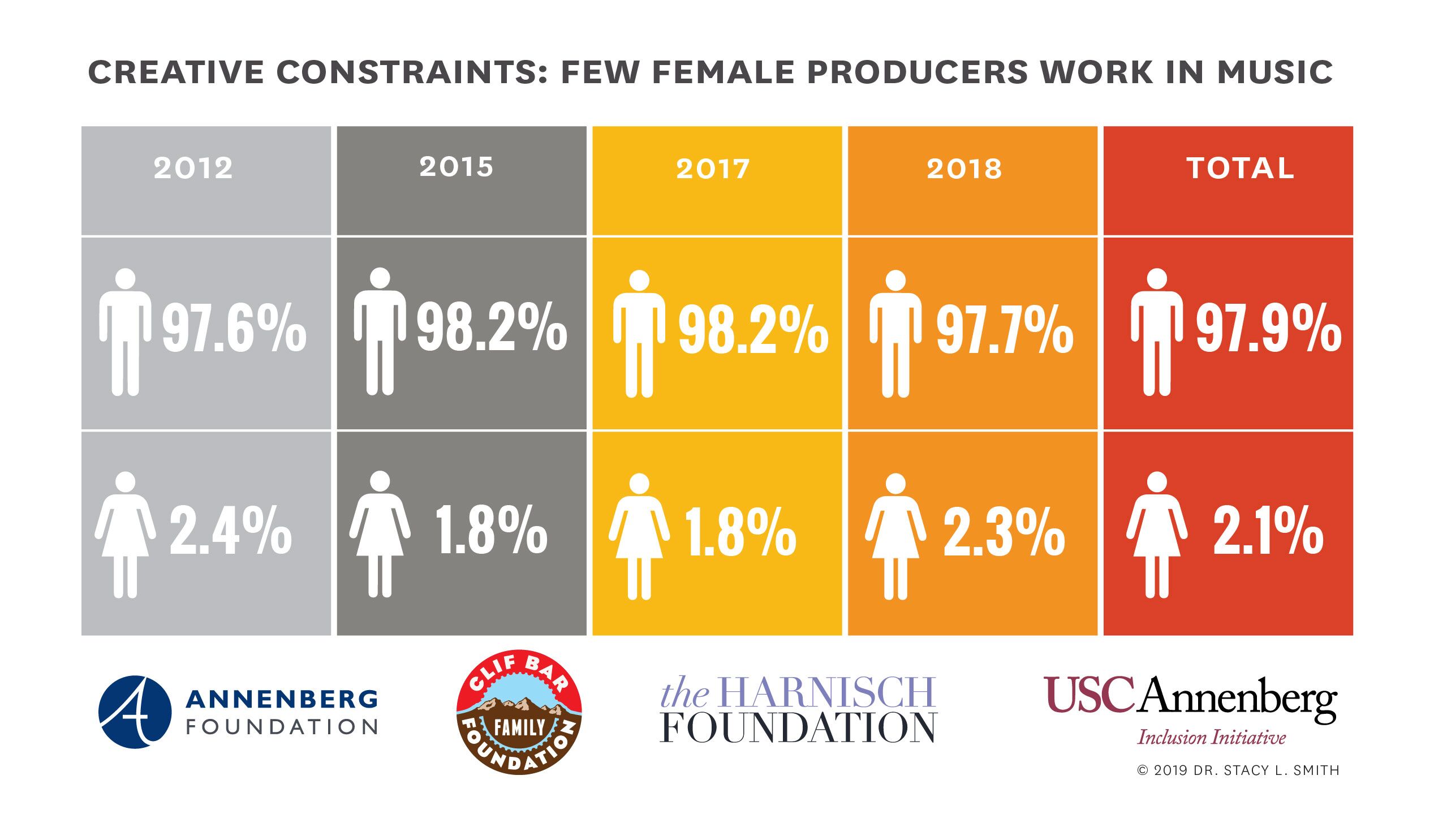A new Time’s Up/Annenberg Inclusion Initiative challenge might be in order. The latter has released its second “Inclusion in the Recording Studio?” report, a study of gender and race in the music industry from 2012-2018, and found that women are still extremely underrepresented as artists, producers, and songwriters. Just 17.1 percent of artists with songs on the Hot 100 charts last year were female, a minuscule increase from 2017’s 16.8 percent. Across all seven years, women represented only 21.7 percent of artists.
It’s not all bad news, though. The study also found that 73 percent of top female artists in 2018 were women of color, a 23 percent increase from the previous year and a seven-year high.
“Once again this year we see a lack of female voices in popular music,” said the Inclusion Initiative’s Dr. Stacy L. Smith. “However, one positive finding is that of the female performers in 2018, 73 percent were women of color. This seven-year high point reveals that the music industry is including women of color in ways that other forms of entertainment are not.”
Women represented 12.3 percent of songwriters from 2012-2018, but 43.3 percent of those women were females of color. More than half of the 633 songs considered did not feature even one woman writer.
The exclusion of women among producers is particularly egregious. Women comprised just two percent of producers in 2018 — and that figure has remained stagnant over the four years evaluated, 2012, 2015, 2017, and 2018. That’s a ratio of 47 male producers to every one female. Only four women of color produced on the 400 songs examined during the timeframe.
“Inclusion in the Recording Studio?” also features findings from interviews with 75 female songwriters and producers. More than 40 percent of participants reported that their work and abilities have been dismissed by colleagues, while 39 percent stated that stereotyping and sexualization have negatively impacted their career.
“Women are shut out of two crucial creative roles in the music industry,” Smith explained. “It was critical to understand what factors contribute to the lack of women songwriters and producers in order to open up more opportunities and create sustainable change.” She continued, “What the experiences of women reveal is that the biggest barrier they face is the way the music industry thinks about women. The perception of women is highly stereotypical, sexualized, and without skill. Until those core beliefs are altered, women will continue to face a roadblock as they navigate their careers,” Smith concluded.
In addition to its findings, “Inclusion in the Recording Studio?” details organizations that fight to level the playing field for women in music. She Is The Music seeks to amplify women’s voices, Spotify’s EQL Studio Residency provides mentorship and work experience opportunities, and the For The Record Collective “is a call to action for inclusion that will feature a first-of-its-kind collection of EPs, docuseries, and live events with music produced, written, and engineered by women.”
Another org working to achieve gender equality in the music industry is Recording Academy’s Task Force on Diversity and Inclusion. Launched last year and chaired by Tina Tchen of Time’s Up, the task force investigates, and seeks to address, barriers and biases present in music, especially the Recording Academy. On Friday it announced the Producer & Engineer Inclusion Initiative, which “calls on any entity or individual responsible for or involved in selecting and hiring producers and engineers to commit to making hiring decisions only after considering a slate of candidates that includes at least two women,” per Variety. The initiative also urges producers to consider “gender diversity challenges” in technical fields when making mentorship and advancement decisions.
The key findings of “Inclusion in the Recording Studio?” are below. The full report is available here.
Artists
- A full 1,455 artists were credited across the sample of 700 songs. In 2018, 82.9% of artists on the year end charts were male and 17.1% were female. This computes into a gender ratio of 4.8 male artists to every one female artist. 2018 (17.1%) was not different from 2017 (16.8%) in terms of female participation. These two years featured the lowest percentages of females on the Hot 100 list across the seven years evaluated.
- In 2018, females only represented 26.2% of credited solo artists which was not different than 2017 but was 9.6 percentage points lower than 2012. Not one woman in a duo or band appeared on the Hot 100 chart of 2018. 2018 was substantially lower than 2012 for female participation in duos and bands.
- For males, the range of credits was from 1-33. Drake held the top spot with 33 solo credits across the sample time frame, followed by Justin Bieber (13 songs) and Chris Brown (13 songs). The range of credits for females was a bit narrower (1-21), with Rihanna the top performer followed by Nicki Minaj (20 songs) and Taylor Swift (12 songs).
- Across 1,455 artists, 56% were white and 44% were from underrepresented racial/ethnic groups. A majority of artists (55.6%) on the 2018 charts were people of color which is well above U.S. Census (39.3%). The percentage of artists of color in 2018 was not different from 2017, but the proportion was meaningfully higher (>5 percentage points) than 2012 (+17.2) and every other year in the sample.
- In 2018, the percentage of women of color on the charts was at a seven year high. A full 73% of female artists were from underrepresented racial/ethnic groups in 2018 which is 23 percentage points higher than 2017 and 40 percentage points higher than 2012. For underrepresented males, 2017 (52%) and 2018 (52%) did not differ. However, the percentage of male artists of color on the charts in 2018 was significantly higher (12 percentage points) than 2012 (40%).
Songwriters
- A total of 3,330 songwriters were credited on the seven-year sample. A full 87.7% were males and 12.3% were females. This calculates into a gender ratio of 7.1 male songwriters to every one female. No changes in the percentage of female songwriters were observed between 2017 (11.5%) and 2018 (12.2%), nor did either of these years vary meaningfully from 2012 (11%).
- Of the 411 female songwriters assessed, 43.3% were from underrepresented racial/ethnic groups and 56.7% were white. However, marked variation was observed over time. 59.4% of female songwriters were underrepresented in 2018 which was higher than 2017 (53.5%). Only 29.8% of female songwriters were women of color in 2012, a percentage substantially lower than 2018.
- Differences emerged by gender among the top performing songwriters. The top male songwriter had over two times as many credits (Max Martin, 39 credits) as the top female songwriter on the year-end charts (Nicki Minaj, 18 credits). The top 10 male songwriters wrote or co-wrote just under a quarter (23%) of all songs in the sample.
- Out of 633 songs, 48 songs (7.6%) were written by at least one female songwriter who did not work with a female artist on the song. A total of 90 songs (14.2%) featured at least one female artist and at least one female songwriter. This is a 6.6 percentage point gain. Female artists may be the key to increasing women’s access and opportunity to write in the music industry. This is imperative, as females face an epidemic of invisibility penning songs. Of the 633 songs, 360 or 57% lacked the presence of a female writer. In stark contrast, only 3 or <1% lacked any male songwriters.
Producers
- Across 400 songs, 871 producers, co producers and vocal producers were credited. 97.9% of producers were male and only 2.1% were female. There has been no change over the four years evaluated, with a gender ratio of 47.4 male producers to every one female producer.
- We removed the 14 songs that repeated across the charts in the time frame examined (4 years), bringing the sample to 386. After this, the total number of female producers reduced to 15 individual women and 17 credits. Eleven of these producers were white and 4 were from underrepresented racial/ethnic groups. Only two women worked twice as producers across the songs evaluated.
Grammys
- 1,064 individuals received a Grammy Award® nomination in 5 select categories from 2013 to 2019. A full 89.6% were male and 10.4% were female, a gender ratio of 8.6 males to every one female. The percentage of female nominees in 2019 was significantly higher than 2018 and 2013. Despite this, 2018 was not different than 2015 or 2016 in the percentage of women nominated.
- While males were the majority of nominees in each category, females were most likely to be nominated for Best New Artist, followed by Song of the Year. In the Record and Album of the Year categories, fewer than 10% of nominees were women. For the first time in the seven years analyzed, a woman (Linda Perry) was nominated for Producer of the Year.
- For female nominees, race/ethnicity was analyzed. Overall, 36.9% of female nominees were women of color. The largest number of underrepresented females received nominations for Album of the Year, followed by Record of the Year and Best New Artist—the latter category grew by 16.1 percentage points from last year’s total.










